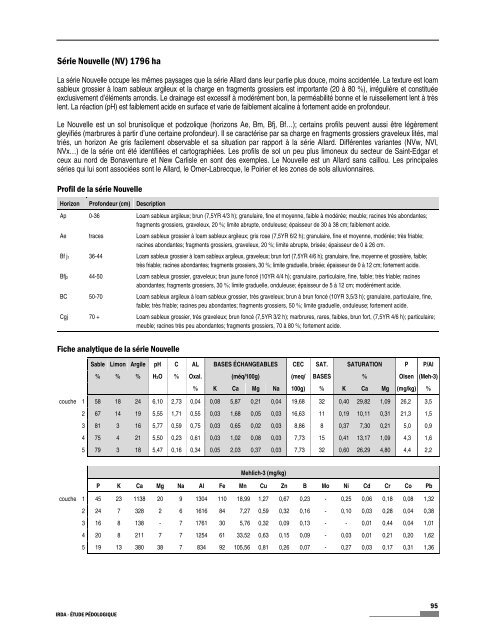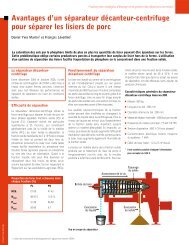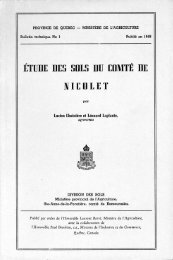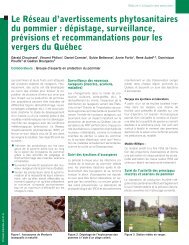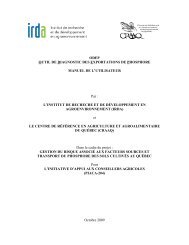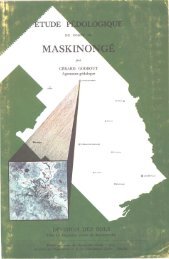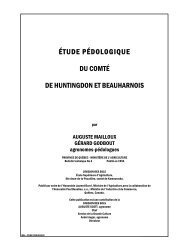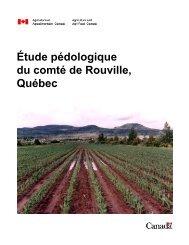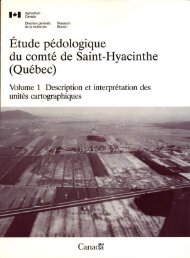Étude pédologique, les terres cultivées de la Péninsule Gaspésienne
Étude pédologique, les terres cultivées de la Péninsule Gaspésienne
Étude pédologique, les terres cultivées de la Péninsule Gaspésienne
You also want an ePaper? Increase the reach of your titles
YUMPU automatically turns print PDFs into web optimized ePapers that Google loves.
Série Nouvelle (NV) 1796 ha<br />
La série Nouvelle occupe <strong>les</strong> mêmes paysages que <strong>la</strong> série Al<strong>la</strong>rd dans leur partie plus douce, moins acci<strong>de</strong>ntée. La texture est loam<br />
sableux grossier à loam sableux argileux et <strong>la</strong> charge en fragments grossiers est importante (20 à 80 %), irrégulière et constituée<br />
exclusivement d’éléments arrondis. Le drainage est excessif à modérément bon, <strong>la</strong> perméabilité bonne et le ruissellement lent à très<br />
lent. La réaction (pH) est faiblement aci<strong>de</strong> en surface et varie <strong>de</strong> faiblement alcaline à fortement aci<strong>de</strong> en profon<strong>de</strong>ur.<br />
Le Nouvelle est un sol brunisolique et podzolique (horizons Ae, Bm, Bfj, Bf…); certains profils peuvent aussi être légèrement<br />
gleyifiés (marbrures à partir d’une certaine profon<strong>de</strong>ur). Il se caractérise par sa charge en fragments grossiers graveleux lités, mal<br />
triés, un horizon Ae gris facilement observable et sa situation par rapport à <strong>la</strong> série Al<strong>la</strong>rd. Différentes variantes (NVw, NVl,<br />
NVx…) <strong>de</strong> <strong>la</strong> série ont été i<strong>de</strong>ntifiées et cartographiées. Les profils <strong>de</strong> sol un peu plus limoneux du secteur <strong>de</strong> Saint-Edgar et<br />
ceux au nord <strong>de</strong> Bonaventure et New Carlisle en sont <strong>de</strong>s exemp<strong>les</strong>. Le Nouvelle est un Al<strong>la</strong>rd sans caillou. Les principa<strong>les</strong><br />
séries qui lui sont associées sont le Al<strong>la</strong>rd, le Omer-Labrecque, le Poirier et <strong>les</strong> zones <strong>de</strong> sols alluvionnaires.<br />
Profil <strong>de</strong> <strong>la</strong> série Nouvelle<br />
Horizon Profon<strong>de</strong>ur (cm) Description<br />
Ap 0-36 Loam sableux argileux; brun (7,5YR 4/3 h); granu<strong>la</strong>ire, fine et moyenne, faible à modérée; meuble; racines très abondantes;<br />
fragments grossiers, graveleux, 20 %; limite abrupte, onduleuse; épaisseur <strong>de</strong> 30 à 38 cm; faiblement aci<strong>de</strong>.<br />
Ae traces Loam sableux grossier à loam sableux argileux; gris rose (7,5YR 6/2 h); granu<strong>la</strong>ire, fine et moyenne, modérée; très friable;<br />
racines abondantes; fragments grossiers, graveleux, 20 %; limite abrupte, brisée; épaisseur <strong>de</strong> 0 à 26 cm.<br />
Bf j1 36-44 Loam sableux grossier à loam sableux argileux, graveleux; brun fort (7,5YR 4/6 h); granu<strong>la</strong>ire, fine, moyenne et grossière, faible;<br />
très friable; racines abondantes; fragments grossiers, 30 %; limite graduelle, brisée; épaisseur <strong>de</strong> 0 à 12 cm; fortement aci<strong>de</strong>.<br />
Bfj2 44-50 Loam sableux grossier, graveleux; brun jaune foncé (10YR 4/4 h); granu<strong>la</strong>ire, particu<strong>la</strong>ire, fine, faible; très friable; racines<br />
abondantes; fragments grossiers, 30 %; limite graduelle, onduleuse; épaisseur <strong>de</strong> 5 à 12 cm; modérément aci<strong>de</strong>.<br />
BC 50-70 Loam sableux argileux à loam sableux grossier, très graveleux; brun à brun foncé (10YR 3,5/3 h); granu<strong>la</strong>ire, particu<strong>la</strong>ire, fine,<br />
faible; très friable; racines peu abondantes; fragments grossiers, 50 %; limite graduelle, onduleuse; fortement aci<strong>de</strong>.<br />
Cgj 70 + Loam sableux grossier, très graveleux; brun foncé (7,5YR 3/2 h); marbrures, rares, faib<strong>les</strong>, brun fort, (7,5YR 4/6 h); particu<strong>la</strong>ire;<br />
meuble; racines très peu abondantes; fragments grossiers, 70 à 80 %; fortement aci<strong>de</strong>.<br />
Fiche analytique <strong>de</strong> <strong>la</strong> série Nouvelle<br />
IRDA - ÉTUDE PÉDOLOGIQUE<br />
Sable Limon Argile pH C AL BASES ÉCHANGEABLES CEC SAT. SATURATION P P/Al<br />
% % % H2O % Oxal. (méq/100g) (meq/ BASES % Olsen (Meh-3)<br />
% K Ca Mg Na 100g) % K Ca Mg (mg/kg) %<br />
couche 1 58 18 24 6,10 2,73 0,04 0,08 5,87 0,21 0,04 19,68 32 0,40 29,82 1,09 26,2 3,5<br />
2 67 14 19 5,55 1,71 0,55 0,03 1,68 0,05 0,03 16,63 11 0,19 10,11 0,31 21,3 1,5<br />
3 81 3 16 5,77 0,59 0,75 0,03 0,65 0,02 0,03 8,86 8 0,37 7,30 0,21 5,0 0,9<br />
4 75 4 21 5,50 0,23 0,61 0,03 1,02 0,08 0,03 7,73 15 0,41 13,17 1,09 4,3 1,6<br />
5 79 3 18 5,47 0,16 0,34 0,05 2,03 0,37 0,03 7,73 32 0,60 26,29 4,80 4,4 2,2<br />
Mehlich-3 (mg/kg)<br />
P K Ca Mg Na Al Fe Mn Cu Zn B Mo Ni Cd Cr Co Pb<br />
couche 1 45 23 1138 20 9 1304 110 18,99 1,27 0,67 0,23 - 0,25 0,06 0,18 0,08 1,32<br />
2 24 7 328 2 6 1616 84 7,27 0,59 0,32 0,16 - 0,10 0,03 0,28 0,04 0,38<br />
3 16 8 138 - 7 1761 30 5,76 0,32 0,09 0,13 - - 0,01 0,44 0,04 1,01<br />
4 20 8 211 7 7 1254 61 33,52 0,63 0,15 0,09 - 0,03 0,01 0,21 0,20 1,62<br />
5 19 13 380 38 7 834 92 105,56 0,81 0,26 0,07 - 0,27 0,03 0,17 0,31 1,36<br />
95


